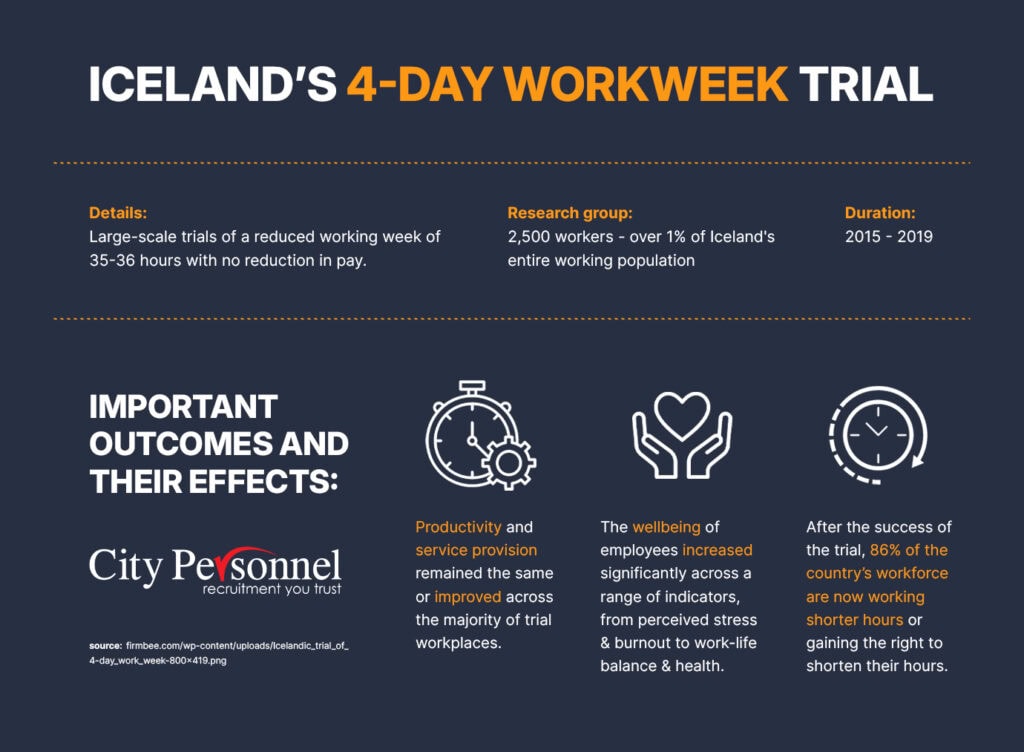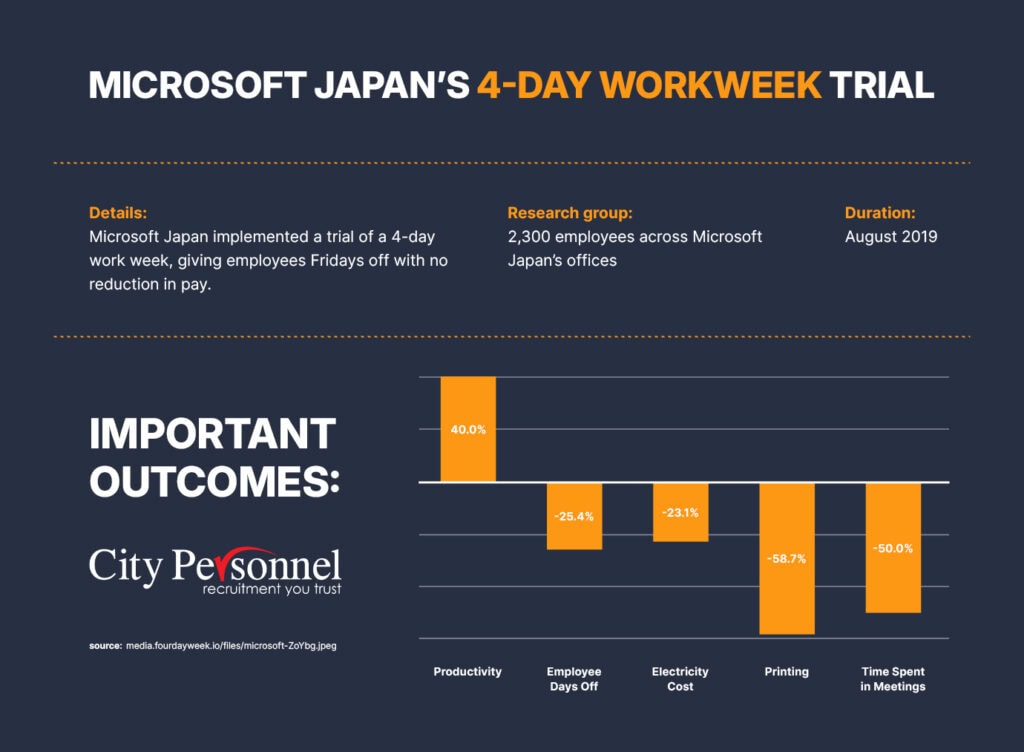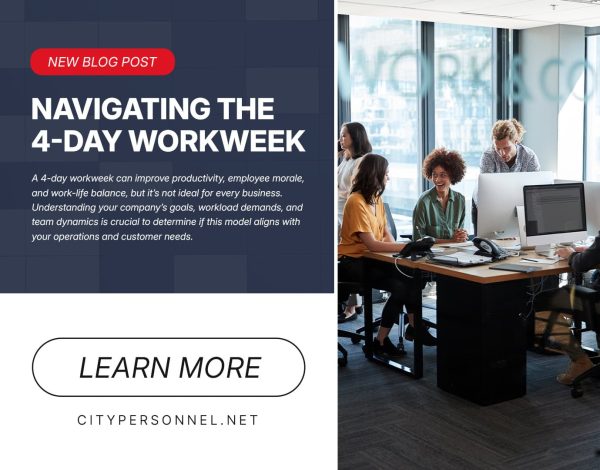A 4-day workweek can improve productivity, employee morale, and work-life balance, but it’s not ideal for every business. Understanding your company’s goals, workload demands, and team dynamics is crucial to determine if this model aligns with your operations and customer needs.
Table of Contents
Introduction to the 4-Day Workweek
What is a 4-Day Workweek?
A 4-day workweek is a schedule where employees work four days each week instead of the traditional five, either by reducing hours to a 32-hour schedule or compressing 40 hours into four days. This model aims to support employee well-being and improve productivity by giving workers more time to recharge. It challenges traditional views on productivity, arguing that employees can achieve similar or even greater outputs in fewer days, provided their work hours are efficient and distraction-free.
Popularity and Global Trends
Interest in a 4-day workweek has surged globally, with countries like Iceland, Spain, and Japan conducting large-scale trials to explore its impact on employee health, productivity, and satisfaction.
For instance, Iceland’s trial saw productivity remain steady or improve, while employee well-being soared, setting a precedent for similar experiments worldwide. In Japan, where burnout and overwork have been long-standing issues, government and private-sector initiatives have backed shortened workweeks to encourage work-life balance and counteract “karoshi,” or death from overwork.
These successes have inspired many organizations to reconsider traditional work schedules as a way to attract talent and increase retention.

Pros of a 4-Day Workweek
Improved Employee Morale and Work-Life Balance
A 4-day workweek can substantially boost employee morale by offering a better work-life balance. With an additional day to focus on personal well-being, family time, or leisure, employees often feel less stressed and more motivated when they return to work. This extra time also gives employees the chance to pursue hobbies, exercise, or simply rest, all of which are crucial for mental health. Companies that have implemented a 4-day workweek report lower turnover rates, as employees feel more supported and valued, leading to increased loyalty and engagement.
Enhanced Productivity and Efficiency
Several studies indicate that shorter workweeks lead to higher productivity as employees are more focused and motivated to accomplish their tasks within the limited timeframe. In a compressed week, employees are often more intentional about their tasks, reducing time spent on unproductive activities or meetings.
Microsoft Japan, for example, found a productivity increase of about 40% during its 4-day workweek trial. Employees prioritize essential tasks and cut down on unnecessary steps, leading to more efficient workflows and outcomes, proving that fewer hours don’t necessarily mean less output.
Reduced Operational Costs
A shorter workweek can reduce operational costs associated with running a physical workspace. With employees spending less time in the office, companies can save on electricity, water, heating, and other utilities.
Additionally, if fewer commuting days are involved, employees may save on transportation expenses, which can indirectly benefit the business by reducing absenteeism and tardiness caused by commuting fatigue. These savings make a compelling case for businesses exploring the 4-day workweek, especially for those looking to optimize resources.
Cons of a 4-Day Workweek
Challenges in Meeting Client and Customer Expectations
One of the main drawbacks of a 4-day workweek is the potential disruption in client and customer service. For client-facing businesses, reducing available workdays might lead to delays or a perceived decrease in accessibility. Some customers may expect support five days a week or even 24/7, especially in industries like healthcare or IT support. Businesses adopting a 4-day week may need to invest in solutions like staggered work schedules or automated customer service options to prevent service disruptions and ensure that clients feel valued and prioritized.
Potential for Increased Workload Stress
While a 4-day workweek can reduce stress by providing an extra day off, it can also have the opposite effect if workloads aren’t adjusted accordingly. Employees may feel pressured to fit five days of work into four, potentially leading to burnout or reduced quality of output. Companies that fail to address workload distribution may find that employees become overwhelmed, which can counteract the benefits of a shorter week.
Effective workload planning and flexible deadlines are essential to make this model sustainable and ensure that employees don’t feel overloaded.
Industry-Specific Limitations
Not all industries are well-suited for a 4-day workweek. Sectors like healthcare, emergency services, retail, and logistics often require consistent coverage throughout the week, making it challenging to adopt a condensed schedule. For these industries, implementing a 4-day workweek could lead to staffing shortages or reduced quality of service. In such cases, alternative models, like rotating shifts or flexible hours, may better address employee well-being while meeting industry demands. Careful consideration is needed to determine whether your specific sector can realistically support this model.
Key Considerations Before Adopting a 4-Day Workweek
Assessing Your Business Model and Client Needs
Before implementing a 4-day workweek, assess your business’s core operations, client expectations, and service requirements. Consider whether your clients are comfortable with fewer contact days or if they rely on regular, frequent updates. Client feedback can be invaluable in understanding if they would support a new schedule.
For some companies, a 4-day week may be feasible only for non-client-facing departments, while others might find that all teams can operate successfully within this framework.
Gauging Team Adaptability and Readiness
Understanding your team’s adaptability and openness to change is vital. Conduct surveys or one-on-one discussions to gauge how employees feel about a shorter workweek and whether they believe they could maintain productivity. This feedback can reveal potential areas of support, such as additional training or flexible hours within the 4-day framework.
Also, consider the varied needs of employees across departments, as some may be more suited to adapt than others, depending on job roles and responsibilities.
Balancing Costs and Benefits
Implementing a 4-day workweek requires a careful analysis of cost savings versus potential downsides. Review potential reductions in overhead costs, but also consider the possible need for additional technology investments or staffing.
For instance, if clients demand 5-day availability, hiring part-time support or investing in customer service automation might be necessary. Calculating these financial implications helps create a clearer picture of the economic feasibility of a 4-day workweek in your business.
Successful 4-Day Workweek Implementation Strategies
Establishing Clear Goals and Metrics
Setting clear, measurable goals and KPIs will help you track the impact of the 4-day workweek on productivity, customer satisfaction, and employee well-being. Consider monitoring performance data, client feedback, and productivity analytics to ensure the shorter workweek is benefiting both employees and the business. These metrics provide a foundation to assess whether the 4-day schedule is sustainable and beneficial over the long term.
Maintaining Open Communication with the Team
Frequent communication is essential during this transition. Regular check-ins, open feedback channels, and a transparent approach to discussing challenges and successes help employees feel supported. If issues arise, like workload imbalance or client complaints, addressing them promptly allows for smoother adaptation. Building a culture of openness and continuous improvement is crucial for maintaining a successful 4-day workweek.
Testing the Model Before Full Implementation
Trialing a 4-day workweek allows you to identify potential pitfalls without committing long-term. For instance, Shake Shack conducted a four-day workweek trial, yielding encouraging results, with managers reporting greater job satisfaction and reduced stress. A pilot program could run for a few months with regular evaluations to gauge its success and make adjustments as needed.
Trials help you see real-world impacts on productivity and morale, enabling a more informed decision. Some businesses use trial results to implement the model gradually, making it easier to scale if the benefits are significant.
Real-World Case Studies
Successful Implementations
As said before, Microsoft Japan is one of the most notable examples of a successful four-day workweek implementation. In August 2019, the company conducted a trial where employees worked four days a week without any pay reduction. The results were striking: productivity increased by 40%, and employees reported higher satisfaction levels.
Additionally, there was a noticeable reduction in operational costs, such as electricity consumption and paper usage, contributing to a more sustainable workplace.

Another example is Buffer, a social media management company that adopted a four-day workweek in May 2020. Buffer initially tested this schedule for a month and extended it due to positive feedback. Employees reported lower stress levels and improved work-life balance, and there was no significant drop in productivity. This experiment aligned well with Buffer’s values of flexibility and employee well-being, and the company has continued with the practice.
Kickstarter, the crowdfunding platform, started a four-day workweek pilot in early 2022. The move was part of their broader effort to rethink traditional work structures and improve employee wellness. Preliminary results showed that employees were happier and felt more creative, which positively impacted their work output. Kickstarter’s leadership highlighted employee retention and recruitment as additional benefits of the new schedule.
Unsuccessful Attempts
While many companies have found success with a four-day workweek, not all experiences have been positive. For instance, the digital marketing agency Treehouse initially switched to a four-day workweek but had to revert back to a five-day schedule. CEO Ryan Carson reported that the reduced schedule hindered the company’s ability to grow and meet client demands effectively.
Despite the initial enthusiasm, the four-day workweek created challenges in maintaining the pace needed for expansion and client satisfaction.
Work in Progress
Shake Shack, the popular fast-food chain, experimented with a four-day workweek for its managers in select locations in 2019. The goal was to improve managerial work-life balance and reduce turnover rates. Early feedback was encouraging, with managers reporting greater job satisfaction and reduced stress.
However, in 2021, the company put the four-day workweek trial on pause due to COVID, and has yet to implement it again. The chain said the program is “on pause” but “there’s always a possibility it could return in the future.”
Is a 4-Day Workweek Right for Your Business?
Factors for Success
The success of a 4-day workweek hinges on your business’s adaptability, the nature of your industry, and the ability to meet client expectations with fewer workdays. Companies that prioritize flexible schedules and emphasize employee well-being tend to benefit most from this model. Reviewing your team’s structure, client engagement, and support systems will help you determine if a 4-day workweek can work in your environment.
Alternative Flexible Work Models
If a 4-day workweek is unfeasible, other flexible work models may offer similar benefits. Options like flexible hours, hybrid work arrangements, 3-2-2 workweek, and remote workdays allow for autonomy without sacrificing customer or client satisfaction. Exploring these alternatives enables you to customize flexibility based on business needs, making it possible to attract talent and improve morale in a way that aligns with your operations.
Conclusion: Embracing Flexibility in the Modern Workforce
The 4-day workweek represents a shift toward flexibility, with proven benefits for employee well-being and productivity. While it may not suit every industry, businesses that successfully implement shorter workweeks often find their teams more motivated, focused, and loyal.
As work models continue evolving, finding the right balance between operational needs and employee satisfaction will remain essential. Whether through a 4-day week or alternative flexibility, embracing adaptable work models supports both business growth and workforce resilience.
Key Takeaways
- Improved Morale and Productivity: A well-structured 4-day workweek can enhance both, but managing workloads is key.
- Suitability Varies by Industry: Evaluate client expectations and your team’s adaptability before making a shift.
- Trial Periods Help: Testing a shorter workweek offers insights with minimal risk.
- Alternative Flexible Work Models: If a 4-day schedule isn’t a fit, explore other flexible work arrangements.
Frequently Asked Questions
A 4-day workweek can improve productivity due to increased focus, reduced time spent on non-essential tasks, and better work-life balance. Studies show employees often accomplish more in fewer hours when they feel rested and motivated.
Common challenges include maintaining client expectations, managing workload distribution, and ensuring sustained productivity. Some businesses may also struggle to adapt customer service to a shorter workweek.
It can be. Reduced workdays often lead to savings on utilities, office supplies, and overhead, but businesses must balance these with any additional costs required to maintain productivity.
It’s possible with careful planning, such as staggered schedules, increased automation, or part-time staffing for client service continuity.
A pilot program helps gauge its impact. Setting clear goals and collecting feedback from employees and clients during a trial phase allows you to make an informed decision about long-term implementation.





